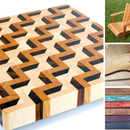Introduction: Hexagon Piecing Tutorial
Hexagon piecing is super easy and fun! It's a great craft to do while hanging out on the couch, and it's extremely portable, so you can craft pretty much anywhere! :D
You can use the sewn hexagons for all sorts of things: patches on clothes, as applique on other sewn goods, as a quilt top, as placemats, as garlands, etc.
In this tutorial I'll go over how to sew the individual hexagons and how to sew them together - keep reading and prepare to get addicted.
Step 1: What You'll Need:
- quilting weight cotton
- needle
- thread
- hexagon template
- cardstock
- scissors
I'm not including a template file here because they're everywhere online. This time I found one at Tim van de Vall's website - you can access his templates here. He has loads more templates too - you should click around. Template heaven!!
I'm using 3 inch hexagons - they're my favorite size and perfect for beginners. (The smaller ones can be so fiddly!)
Before you get started, you'll want to print out some hexagon templates. Make sure your printer is printing at 100% and not scaling the size of the image in a weird way.
I prefer to use cardstock for the templates because it's easier to sew the hexagons when they're more rigid - and you can reuse the cardstock for the next round! :)
Step 2: Prepping for Sewing
Once you have your templates, you'll want to prep some fabric!
Iron all your fabric first - it's important that it be unwrinkled so the hexagons sew nicely.
There are a couple different ways to cut your fabric:
- Cut the fabric into a hexagon, leaving 1/4 - 1/2 inch all around the edges
- Or cut a square of fabric one inch larger than your template
I always go for squares! It's much faster and doesn't really add bulk. Since I'm using a three inch hexagon template, I cut four inch squares.
If you're able, but the squares out using pinking shears or a rotary cutter fitted with a pinking blade. Guarding yourself against unraveling fabric is always good :D
Step 3: Sewing the Individual Hexagons
Here are the steps I go through to sew each hexagon:
- Thread a needle (I go with single threaded) with a little less than an arm's length worth of thread and make a nice knot at the end.
- Lay a piece of fabric wrong side up and put the cardstock hexagon template in the middle.
- Fold the fabric over the diagonal edge to the left.
- Fold over the top edge of the fabric - make sure both folded edged are nice and taut!
- Where the two folds meet, push the needle through the fabric once and pull until the knot is resting on the fabric.
- Pass the needle back through the folded corner again to make a second stitch.
- Fold the next edge of the fabric down to form another corner and make sure it's tight.
- Push the needle through the next corner and bring it back over one more time for another stitch.
- Continue folding and stitching all the way around until you hit the corner you started on with the knot.
- Pass the needle through the first corner again and knot the thread well and cut off the excess.
Make sure that you never push through the cardstock. Use it as a guide to make sure you're only sewing where you need to be.
(It's important to note that I do not pin my cardstock to the fabric. I don't think it actually helps. Just go with it and they'll turn out fine - promise!)
Step 4: Now Make Lots of Them!
After the first few, you'll start getting really quick at them.
Pro tip: as you sew them, stack them under something a little heavy. It's like pressing them again with an iron without having to actually get up and iron things. Awesome.
I normally use a coffee mug or in this case, my full water bottle.
Step 5: Sewing Hexagons Together in Pairs or Rows
This part is simple - not any harder than sewing the individual hexagons. :)
Here's what a do:
- Place two hexagons right sides facing
- Single thread a needle and make a substantial knot at the end
- Start where two of the corners meet and push the needle through both of the hexagons at the very edge.
- Use a whipstitch to go from one corner to the other - lots of little tight stitches is best!
- Knot the thread well at the other corner and cut off the excess.
The cardstock will help you here too - use it as a guide to make sure you're not going too far into the hexagon. You just want to sew the very edge!
Check out the second photo to see how they should look once you sew them - nice and tight at the seam with no gaps or visible stitches.
I like to make rows of hexagons and then sew them together, but it's really all about how you want to work! If you want to get right into sewing them together in different ways, check the next step!
Step 6: Sewing Complex Hexagon Shapes
If you're sewing together two long rows, you can whipstitch the top two hexagons together really easily and then start sewing the rest of it together. Whipstitching the first two lays the foundation for the rest and makes it easier to keep them together. :D
Once the first pair is whipstitched together, lay your work down on a flat surface and thread the needle again with an arm's length of single thread with a nice knot in the end.
Continue sewing the rest together using a ladder stitch or something similar. (The third photo is a nice close up to show you how I was doing it.) Pay special attention to the corners and make sure they're nice and secure. Keep your stitches tight.
Don't push through the cardstock to the front of the hexagon - use it as a buffer to make sure your stitches are staying on the back of the hexagon.
Step 7: Removing the Cardstock
Once you've got your hexagons sewn together, you can remove the cardstock. Don't remove the cardstock if you're intending to sew more hexagons to the piece: sewing floppy hexagons is hard.
If you're working on a really big piece, feel free to remove all the cardstock that isn't on the outer edge of the piece - you just need to make sure the edges you're going to keep adding to are reinforced. :D
Enjoy and let me know if you have any questions!





